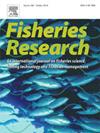Effects of capture and handling on striped bass (Morone saxatilis) in the recreational fishery of coastal Massachusetts
IF 2.3
2区 农林科学
Q2 FISHERIES
引用次数: 0
Abstract
Striped bass (Morone saxatilis) are a highly valued recreational fishery along the eastern coast of North America, with most hooked fish released voluntarily or due to regulations. Understanding how striped bass respond to capture and handling, particularly air exposure, is crucial for improving management and angler practices to maximize post-release survival. This study evaluated the physical and physiological condition of 521 striped bass subjected to catch-and-release angling across different gear and tackle types and five air exposure treatments using reflex action mortality predictors. A subset of striped bass (n = 37) caught on conventional gear and double treble hook lures were fitted with triaxial accelerometer biologgers to assess short-term post-release activity across three air exposure treatments. Reflex impairment increased with higher water temperatures, longer fight and handling times, increased air exposure, and hooking in locations other than the jaw. Physical injury from foul hooking was more frequent with conventional gear, while deep hooking occurred more often with fly gear. Post-release activity was influenced by time following release, with higher activity observed in striped bass not air exposed compared to those exposed for 30 s and 120 s. Within 20 min of release, all fish survived, demonstrating resilience to the tested conditions. Our findings suggest that anglers can minimize their impact by using single hooks, reducing fight and handling times, limiting air exposure, and avoiding high water temperatures, especially for striped bass larger than 65.4 cm. These findings can inform management decisions and hone best practices for catch-and-release of striped bass.
马塞诸塞州沿海休闲渔业中条纹鲈鱼捕获和处理的影响
条纹鲈鱼(Morone saxatilis)是北美东海岸一种非常有价值的休闲渔业,大多数被钩住的鱼都是自愿或由于法规而被释放的。了解条纹鲈鱼对捕获和处理的反应,特别是对空气暴露的反应,对于改善管理和垂钓者的实践,以最大限度地提高放生后的存活率至关重要。本研究利用反射作用死亡率预测因子评估了521条条纹鲈鱼在不同渔具和钓具类型和五种空气暴露处理下的生理和生理状况。用传统渔具和双三钩鱼饵捕获的条纹鲈鱼子集(n = 37)安装了三轴加速度计生物学家,以评估三种空气暴露处理下的短期释放后活性。水温越高,打斗和处理时间越长,暴露在空气中的时间越长,以及钩在下颚以外的地方,反射损伤就会增加。常规齿轮造成的身体伤害较多,而飞齿轮造成的身体伤害较多。释放后活性受释放后时间的影响,未暴露于空气中的条纹鲈鱼的活性高于暴露于30 s和120 s的条纹鲈鱼。在释放的20 分钟内,所有的鱼都存活了下来,显示出对测试条件的适应能力。我们的研究结果表明,垂钓者可以通过使用单钩,减少战斗和处理时间,限制空气暴露,避免高水温来减少其影响,特别是对于大于65.4 厘米的条纹鲈鱼。这些发现可以为管理决策提供信息,并为条纹鲈鱼的捕获和释放提供最佳实践。
本文章由计算机程序翻译,如有差异,请以英文原文为准。
求助全文
约1分钟内获得全文
求助全文
来源期刊

Fisheries Research
农林科学-渔业
CiteScore
4.50
自引率
16.70%
发文量
294
审稿时长
15 weeks
期刊介绍:
This journal provides an international forum for the publication of papers in the areas of fisheries science, fishing technology, fisheries management and relevant socio-economics. The scope covers fisheries in salt, brackish and freshwater systems, and all aspects of associated ecology, environmental aspects of fisheries, and economics. Both theoretical and practical papers are acceptable, including laboratory and field experimental studies relevant to fisheries. Papers on the conservation of exploitable living resources are welcome. Review and Viewpoint articles are also published. As the specified areas inevitably impinge on and interrelate with each other, the approach of the journal is multidisciplinary, and authors are encouraged to emphasise the relevance of their own work to that of other disciplines. The journal is intended for fisheries scientists, biological oceanographers, gear technologists, economists, managers, administrators, policy makers and legislators.
 求助内容:
求助内容: 应助结果提醒方式:
应助结果提醒方式:


